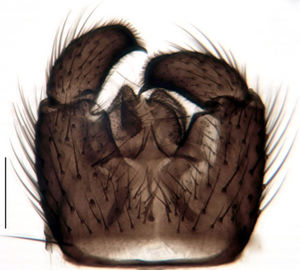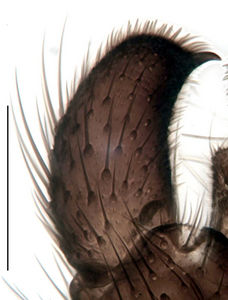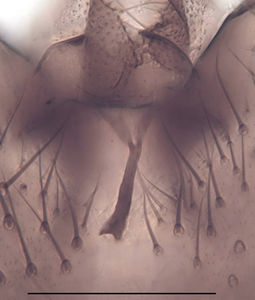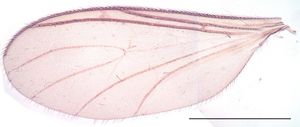Trichosiopsis suecica
Ordo: Diptera
Familia: Sciaridae
Genus: Trichosiopsis
Name
Trichosiopsis suecica unpublished
Type material
Holotype: ♂, 03.06.2014, sweep netting, leg. Gammelmo & Olsen, bf-sci-00396 in NHMO
Type locality
Norway, Buskerud, Ringerike
Barcoded material
| Stadium | Country | Province | Locality | Habitat | Method | Date | Collector | Collection Number | Collection | Latitude | Longitude | Elevation (m) |
|---|---|---|---|---|---|---|---|---|---|---|---|---|
| 1 ♂ (holotype) | Norway | Buskerud | Ringerike, Synneren NR | carr | sweep netting | 03.06.2014 | Øivind Gammelmo & Kjell-Magne Olsen | bf-sci-00396 | NHMO | 60.1228 | 10.2110 | 75 |
Other material studied
Norway: 1 ♂,Telemark, Kragerø, Frydensborgtjenna, Malaise trap, Olberg, 17.8.-28.09.2009, PKHH 8699; Sweden: 1 ♂, Ångermanland, Skuleskogen National Park, Långrå: brook ravine in mixed forest, Malaise trap, Swedish Malaise Trap Project, 28.6.-05.07.2004, PKHH 7491; 1 ♂, Östergötland, Omberg, Storpissan: old Norway spruce wood, Malaise trap, Swedish Malaise Trap Project, 28.5.-05.07.2005, NHRS 3564; 1 ♂, Södermanland, Nämdö, Södermanlands län, Krokudden, Krokvik, spruce and pine forest, Malaise trap, Swedish Malaise Trap Project, 5.7.-07.08.2008, PKHH 7356; 1 ♂, Södertälje, Tullgarns näs, Rävsalaviken, mixed forest next to pasture, Malaise trap, Swedish Malaise Trap Project, 3.7.-19.08.2004, PKHH 7486; 3 ♂, Torne lappmark, Nikkaluokta, young birch/willow forest along stream, Malaise trap, Jaschhof & Jaschhof, 14.7.-05.08.2005, PKHH 5938, NHRS 1071/1075 [as Leptosciarella rejecta (partim) in Heller et al. (2009[1]: 40)]; 13 ♂, Upland, Älvkarleby, Batfors, pine forest with blueberry, Malaise trap, Swedish Malaise Trap Project, 27.6.-01.07.2004, PKHH 7449-7452/7464/7465/7467-7469, NHRS 4598/4596/4598; 3 ♂, Biskops-Arnö, northern beach, elm grove, Malaise trap, Swedish Malaise Trap, 20.6.-18.07.2005, PKHH 7389/7391; 1 ♂, Svartlöga, Matkrok, maritime deciduous wood, Malaise trap, Swedish Malaise Trap, 19.7.-18.08.2005, PKHH 7422.
Description (male)
Head. Eye bridge 3–5 rows of facets. Antenna unicolour. LW-index of 4th flagellomere 1.98–2.3; neck 0.25–0.38 × segment width; transition of basal part to neck pronounced. Colour of neck unicolour. Antennal setae shorter than segment width; of normal strength; dense; salient. Palpus darkened; of normal length; palpomeres 3. First palpomere elongate; with 3–6 setae; with only sparse sensilla. Second palpomere short and oval, or elongate. Third palpomere as long as first. Thorax. Colour brown. Notum unicolour. Thoracic setae long and strong, or normal; black, or brown. Posterior pronotum bare, or setose. Postpronotal setae 0–1–4; fine. Mesothoracic sclerites bare. Legs. Colour yellow. Hind coxa of same colour as femora, or darkened. Setae on front coxa black. Front tibial organ as patch of setae; dark; front tibial organ not bordered. Tibial setae on hind legs normal, shorter than tibial width. Tibial spurs of equal length. Claws untoothed. Wing. Wing slightly darkened; of normal shape. Wing membrane without macrotrichia. Wing venation weak, with faint stM. M-fork of normal shape. R1 ending at or slightly before base of m-fork; posterior veins with macrotrichia; stM mostly with macrotrichia; CuA1 and CuA2 mostly with macrotrichia; bM bare; r-m with few setae; bM:r-M 0.8–1.2; st-Cu:bM 0.3–0.6; R1:R 1.4–1.8; c:w 0.6–0.72. Halter darkened; of normal length. Abdomen. Abdominal setae strong; on tergites black; on sternites black. Hypopygium concolour with abdomen; LW-index 0.6–0.77. Base of gonocoxites with strong setae; gonocoxites broadly separated; inner margin of gonocoxites typically U-shaped; inner membrane of hypopygium bare, or scarcely setose; ventral margin of gonocoxite with short setae. Gonostylus elongate; LW-index 2.05–2.35; Inner margin straight, or concave; apex equally rounded. Apical tooth present; without internal structure; of medium strength; LW-Index 1.6–2. Awl-like setae normal; present beneath apical tooth. Megasetae absent. Whiplash-hair absent. Tegmen 0.5–0.8 × longer than broad; rectangular with rounded edges; without special features; central process absent. Length of ejaculatory apodeme/hypopygium 20–40 %; base of ejaculatory apodeme present. Field with aedeagal teeth clearly visible. Measurements. Body size 2.3–3.8 mm. Hind tibia 1.7–2 mm. Wing length 3.1–3.9 mm.
Diagnosis
The species is placed in the Trichosiopsis rejecta group, although the gonostylus does not show the typical distinctive apico-dorsal angle, but is nearly completely rounded. This character alone would instead place Tr. suecica in the Trichosiopsis pilosa group, but those species do not bear long setae at the base of the gonocoxites. This intermediate combination of characters is therefore one way to identify the species. Additionally the awl-like spines beneath the apical tooth are quite short and very dense with dispersed fine setae in between. This give the gonostylus a rather "soft" appearance. The legs are yellow and the front tibiae bear some strong and dark setae. The most similar species is Trichosiopsis defecta, with which it was identified previously on Species-ID. Tr. defecta has a more slender, angulate gonostylus, stronger awl-like setae and a stronger apical tooth than Tr. suecica. Another similar species is Trichosiopsis kleebergi. For distinction see under the latter.
DNA Barcoding
The COI sequence is assigned to BIN BOLD:ACV2317 (n=1, K2P: 11.08%).
Etymology
lat. Suecia = Sweden. The name refers to the country, where the species was first discovered.
Discussion
It may seem curious, that for a species called "suecica" a holotype from Norway was chosen. It was considered, that it is more reliable to take the only DNA-barcoded specimen to prevent possible future misinterpretation for the case, that cryptic species like Tr. kleebergi should still be discovered in this complex.
Distribution
Norway, Sweden.
Images
|
References
- ↑ Heller, K.; Vilkamaa, P.; Hippa, H. 2009: An annotated check list of Swedish black fungus gnats (Diptera, Sciaridae). Sahlbergia, 15(1), 23-51.





